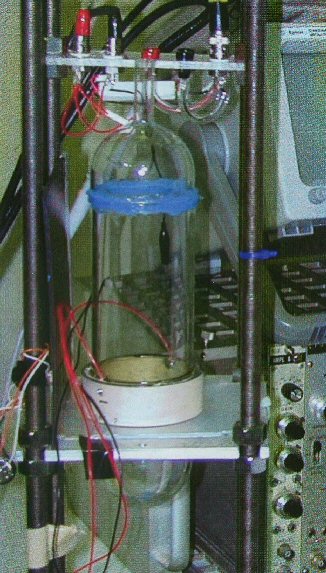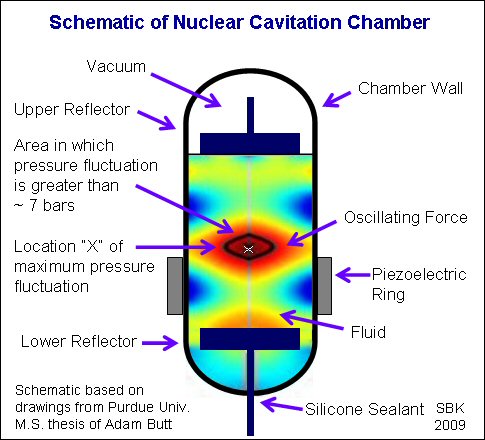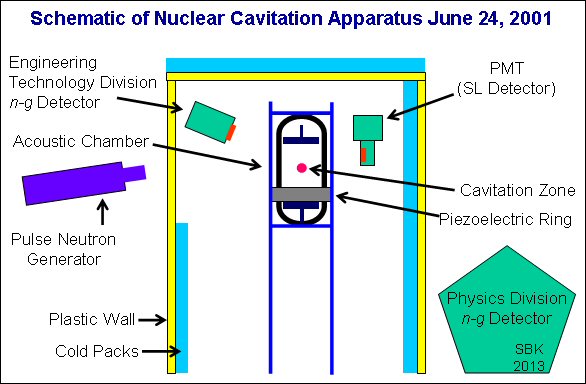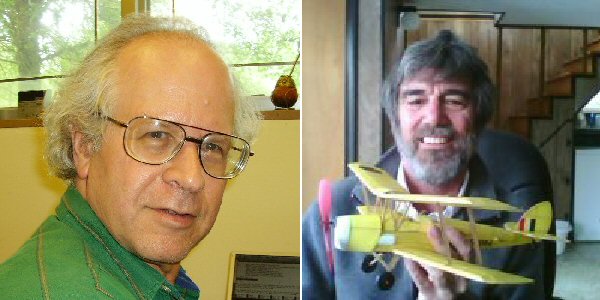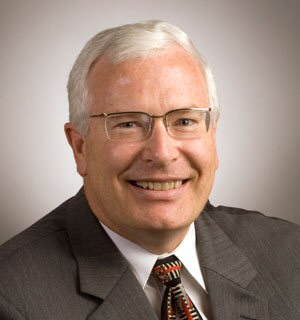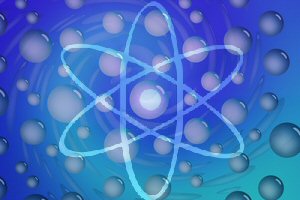
Oak Ridge Nuclear Cavitation Confirmation
July 20, 2013 – By Steven B. Krivit –
This is Part 3 of “2001 Oak Ridge Nuclear Cavitation Confirmation Uncovered.”
This is a New Energy Times Special Report. The first part of this series published on July 18, 2013.
Nuclear Cavitation Evidence
The Taleyarkhan group’s criteria for the successful observation of nuclear cavitation was based on its analyses of tritium, as well as neutrons, above background. In one of the internal ORNL reviews, a member of the management staff referred to the tritium evidence as the smoking gun. The reason for this is that tritium is unambiguous evidence of a nuclear reaction. It is unstable, and because of its short half-life, any measured tritium can have come only from a man-made device.
The Taleyarkhan group measured excess tritium and excess neutrons only when cavitation was on and only during experiments that used chilled deuterated acetone, thus clarifying the cause-and-effect relationship. In their Feb. 20, 2002, document, Shapira and Saltmarsh glossed over the measured excess tritium and neutrons and instead created a new criterion. Neither Shapira nor Saltmarsh had any experience in any aspect of cavitation, including sonoluminescence.
According to Shapira and Saltmarsh’s new criterion, the valid test for nuclear cavitation should confirm that, for each neutron detected, researchers should be able to match the coincidences of each neutron, within a few nanoseconds, to each associated sonoluminescence (SL) flash for each bubble implosion. This is the time a 2.45 MeV neutron would take to reach the detector from the center of the flask.
Shapira and Saltmarsh, by ignoring the valid criteria, creating a dubious criterion, and inflating and promoting the importance of their new criterion, succeeded in convincing most people that the Taleyarkhan group’s experiment failed.
According to Shapira and Saltmarsh, confirmation of the coincidences was required to prove that the neutrons were coming from the reactions. Shapira and Saltmarsh implied that the Taleyarkhan group lacked the ability to discern the precisely timed bursts of neutrons emitted from the pulse neutron generator (PNG) from the neutrons created and emitted from the nuclear cavitation reaction. Despite the fact that the PNG was on during all runs, active as well as control runs, excess neutrons were detected only when cavitation was on, only when deuterated acetone was used, and only when it was chilled.
The Taleyarkhan group’s experiment used multi-bubble sonoluminescence rather than single-bubble sonoluminescence. Neutron-nucleated MBSL, as opposed to SBSL, produces hundreds of neutrons at a time as they collectively implode over many microseconds. Additionally, light flashes from inside the bubble cloud may not even emanate because of absorption or scattering. The Taleyarkhan group looked for general time-correlated signals but never relied on nanosecond coincidences as an essential part of its success criteria. Coincidence measurements were possible but unrealistic, as Richard T. Lahey and Colin West explained to New Energy Times.
“The timing issue is a red herring,” Lahey wrote, “because, in our bubble fusion work, we do NOT have a single bubble collapsing, as [other researchers have in [their] sonoluminescence experiments. Rather, we have a cluster of bubbles collapsing where the interior bubbles can emit … neutrons at different times.”
Despite the valid tritium and neutron singles counts (singles are neutron counts alone as opposed to neutron and SL flash coincidence counts) in the Taleyarkhan group experiment, Shapira and Saltmarsh made it appear in their Feb. 20, 2002, and March 1, 2002, critique of the Taleyarkhan group’s work that the group’s claim wasn’t real.
“We conclude that there is no evidence of any real coincidences in this experiment,” Shapira and Saltmarsh wrote.
Shapira and Saltmarsh Knew (Spring 2002)
At that time, Feb. 20, 2002, most of the insiders knew that the Taleyarkhan group had measured statistically significant excess tritium and/or neutron singles. Most outsiders did not. Outsiders also knew nothing about the checks and controls the Taleyarkhan group had used. They also had no idea that the Taleyarkhan group’s claim was not primarily based on coincidences. With the exception of specialists, most outsiders had little, if any, awareness of the crucial distinctions between the neutron singles data and the neutron coincidence data.
Under these circumstances, Shapira and Saltmarsh’s premature release of their paper — which was supposed to publish concurrently with the Taleyarkhan group’s paper in Science — successfully accomplished the mission of its authors.
In their documents, Shapira and Saltmarsh wrote that the Taleyarkhan group’s experiment showed “no evidence of any real coincidences.” In talking with the media, however, Shapira and Saltmarsh said that the Taleyarkhan group’s experiment showed “no real neutrons.” Non-specialists would not have recognized the difference. It was a crucial distinction, as important as, for example, the difference between speed and acceleration.
Not only did most science journalists miss the distinction, but so did the ORNL science writers who produced a press release on the Taleyarkhan group’s forthcoming Science paper.
Shapira and Saltmarsh’s pre-release of their critique went out before Science published the Taleyarkhan group’s paper. According to Shapira and Saltmarsh, they had disproved the Taleyarkhan group’s claim.
Not only was there excess tritium production in the Taleyarkhan group’s experiment, checked by a resident ORNL expert, but also Shapira and Saltmarsh knew it.
Not only were there excess neutrons in the Taleyarkhan group’s experiment, but also Shapira and Saltmarsh knew it.
Not only was there excess neutron production only when cavitation was on and only during experiments that used chilled deuterated acetone in the Taleyarkhan group’s experiment, but also Shapira and Saltmarsh knew it.
Not only had the Taleyarkhan group measured excess neutrons with its detector, but so did Shapira and Saltmarsh, independently with their own detector.
Several months after the Taleyarkhan group’s paper published in Science, Shapira and Saltmarsh published their own peer-reviewed paper in Physical Review Letters. They wrote that they had “repeated the experiment of Taleyarkhan et al.” and that their experiment didn’t work. As New Energy Times learned last year, they never performed their own experiment. Rather, they took measurements – in fact only neutron measurements – from one of the Taleyarkhan group’s experiments during a two-hour period in Taleyarkhan’s lab on July 24, 2001.
Even if Shapira and Saltmarsh had performed their own experiment and failed to obtain positive results, one failure to replicate does not negate another researcher’s positive claim. Only specific findings of experimental or analytical error of an originator’s experiment can negate a positive claim.
Next Part: The Discovery Team
Questions? Comments? Submit a Letter to the Editor.


